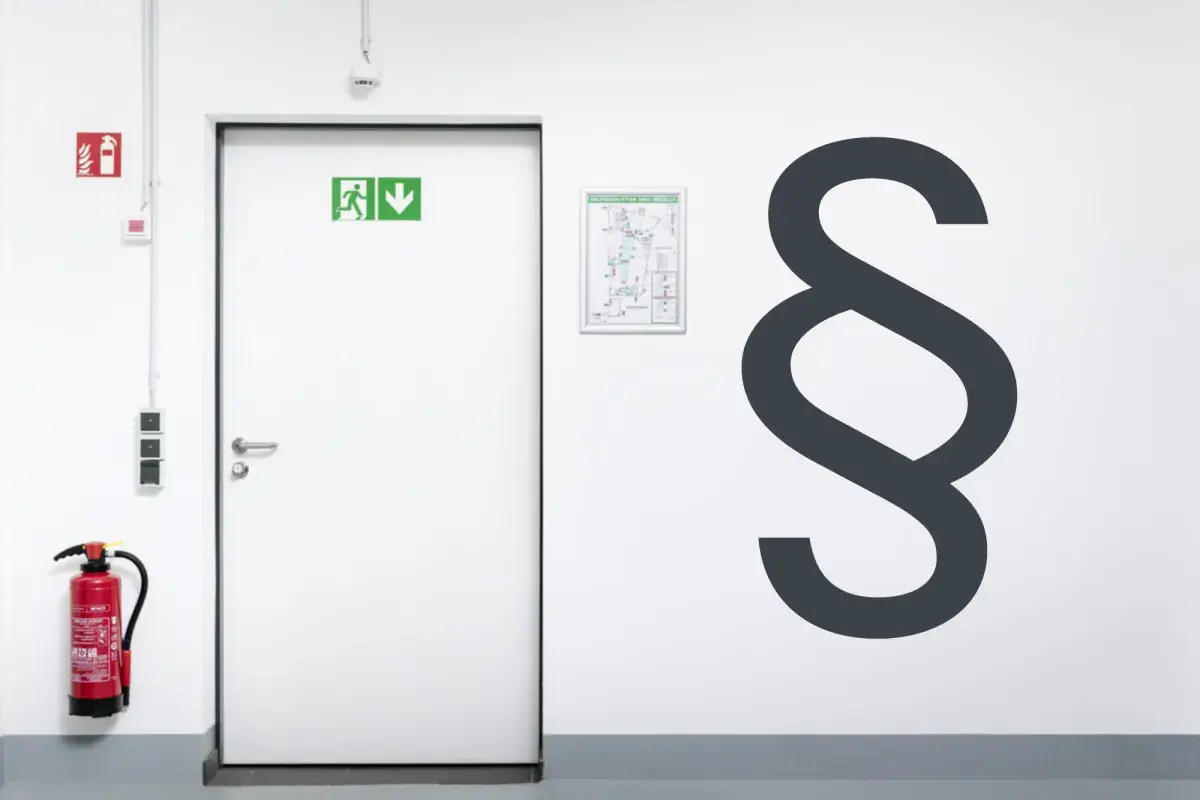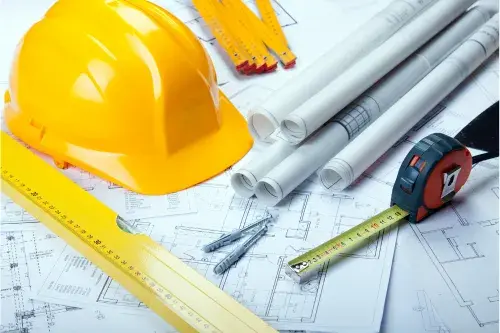Whether it is a new building or a renovation, if fire protection is not taken into account in time, it can lead to expensive and delayed completion. We would like to give architects, builders, operators, fire protection officers and building services planners who are not confronted with fire protection planning every day an overview of the fire protection planning process.
Construction and fire protection: Planning is the key

In building projects, architects and builders are faced with the question of when fire protection should be integrated into the construction planning. In short: the earlier, the better. Especially when it comes to more complex building projects (e.g. special buildings), a specialist planner for preventive fire protection must be involved in the early stages. This person has the necessary expertise and experience, works closely with the building planners and supports the client during the completion of the building or installation and acceptance of the fire protection equipment. Cost-efficient planning plays a major role in this. Fire protection planning affects current costs (installation) as well as future costs (maintenance). This should be taken into account from the very beginning.
Requirements and regulations for fire protection planning
In order to obtain building permission, a fire protection concept must be submitted. The following minimum requirements must be taken into account in this fire protection concept:
- Building regulations according to MBO / model building code
- Specifications of the (fire) insurers
- Specifications of the building operator or the customer
Further fire protection requirements may be influenced by other technical, constructional or organisational matters. A team with responsibilities from each area should be present in the early planning phase so that nothing stands in the way of a building permit and later acceptance.

Biggest challenge

The more complex a building project, the more difficult it is to bring all those involved together and to establish a common understanding as well as to define tasks and responsibilities. Fire protection technology and building technology, for example, have some overlapping points, e.g. the behaviour of fire protection systems in the event of a power failure. In addition to the written planning and the direct exchange, it also helps to look at the interaction at previous customers either on site or with the help of visual material.
Fire protection planning for new building
We would like to explain the process from a fire protection point of view using the example of a new building. Since every building is individual, the procedure may differ in practice. Nevertheless, you can use this procedure as a rough guide to get a better understanding.
1. Check of the building class for standard buildings and thus the fire protection specifications. For special buildings, a specialist planner for preventive fire protection according to MBO/model building code must be present.
2. Define fire protection target and expand or adapt according to fire protection specifications. Take fire insurance requirements into account.
3. Consider the interaction between organisational, structural and technical fire protection as well as with other trades such as technical building equipment.
4. Preparation of the fire protection concept. All defined fire protection specifications and measures are recorded in a service catalogue.
5. Creation of the building concept. The fire protection requirements, as well as the requirements of the other planners, are combined by the architect into a building concept, which is submitted to the building authority for the building permit.
6. Obtain building permit. The building authority checks requirements and measures. Corrections may be necessary. In the best case, the building permit is granted directly.
7. Preparation of the execution plan by the architect with the respective specialist planners. Central question: Which individual service of each trade must be completed, when and by whom? Special attention must be paid to dependencies.
8. Call for tenders. In the case of public projects or very large projects, invitations to tender are issued. Contractors such as fire protection companies can submit a bid on the basis of the (fire protection) service catalogue provided and thus "compete" for the execution. The contract is awarded to the company that is the cheapest or best suited in terms of performance/ competence.
9. Implementation phase. Now the defined measures are implemented, e.g. the installation of a fire alarm system with appropriate detectors and sensors, fire brigade key depot and fire brigade run cards. A fire protection planner can also take over the coordination of the different fire protection trades. An inspection expert ultimately inspects the fire protection device and gives approval for use.
10. Building approval. The fire protection system can now be put into operation. The trades are usually approved individually. Finally, there is a final inspection by employees of the building authorities, who finally approve the entire building.
The fire protection planning is complete from here on. For many fire protection systems, however, there are prescribed maintenance and inspection intervals that must be carried out and recorded by competent persons (such as CWS Fire Safety) or by inspection experts.

Here are a few examples from practice
Fire protection planning: Example fire doors

Fire doors must always remain closed. This is ensured by a self-closing mechanism. However, opening the doors every time you go in and out is a nuisance at frequently used access points. As a result, fire doors are illegally wedged and damaged, for example at tea kitchens and copier rooms. Costly repairs are then necessary to restore the fire protection function. Well thought-out fire protection planning prevents this problem from arising in the first place. It provides for the installation of hold-open systems approved by the building authorities right from the start. The fire doors close automatically in case of fire, but otherwise they may remain open during operating hours.
Coordinate fire protection with production processes
What is also important for companies: production processes and fire protection planning can influence each other. For this reason, building owners should think ahead with the fire protection expert at their side about how extensions, restructuring and conversions of a building can be realised in the future with as little effort as possible. An early exchange and understanding of what work is necessary has a positive effect on the implementation and the result.
For example, when walls and corridors are redesigned in existing buildings, drywall is often used. If fire protection requirements apply to these walls, approval details of stud frames, wall and ceiling connections down to the last screw must be observed. Timely planning, a selection of materials that conforms to approval requirements and continuous monitoring of the work are recommended in order to counteract construction delays.

Fire protection planning for special buildings
In the case of special buildings, however, special solutions are the order of the day. Here, fire protection planners show options for deviations from the standard and compensation possibilities that make complex projects approvable and thus realisable. Often, such well thought-out solutions also lead to greater cost efficiency. The client benefits from this. In contrast, fire protection measures planned at a later date often have the opposite effect. Experience shows that other skilled trades (e.g. building walls, laying electrical cables) forget that fire protection regulations also exist for them because these were not taken into account in the planning. Classics are electrical and piping construction. There can also be collisions. For example, if the required distances for a fire compartmentation in conformity with the approval are not observed and cables that have already been laid have to be re-routed. This causes both delays and additional work. Involving fire protection experts at a very early stage helps to avoid implementation errors.
One person responsible for all fire protection trades

It makes sense to appoint a fire protection construction supervisor in addition to the fire protection planner. Specialist site managers check the proper execution of the fire protection work at intervals that depend on the progress of construction. They sign the fire protection monitoring certificate required for building acceptance.
Bringing fire protection experts on board at an early stage pays off. Building owners and architects benefit from comprehensive expertise, viable, efficient solutions and, last but not least, smooth construction progress.
